Our old-fashioned peach cobbler is the ultimate comfort dessert, featuring a sweet biscuit crust that’s thick and flaky, perfectly complementing the gooey baked peaches beneath. The flavor of fresh peaches gets preserved with lemon zest and juice, adding a refreshing citrus note that elevates the natural sweetness. It’s super simple to make using mostly just common pantry ingredients. Serve it warm with a scoop of vanilla ice cream or a dollop of whipped cream for a treat that’s out of this world delicious!
While you wait for your peach cobbler to bake, indulge in a bowl of peaches and cream. You deserve it.
Why Our Recipe
- Our recipe has a sweet biscuit crust that’s thick and flaky, rather than soft and cakey. Tender and crisp, perfectly complementing the gooey peaches.
- A little lemon brings out more flavor from the peaches.
- Can be used with canned, frozen, or fresh peaches of any variety.
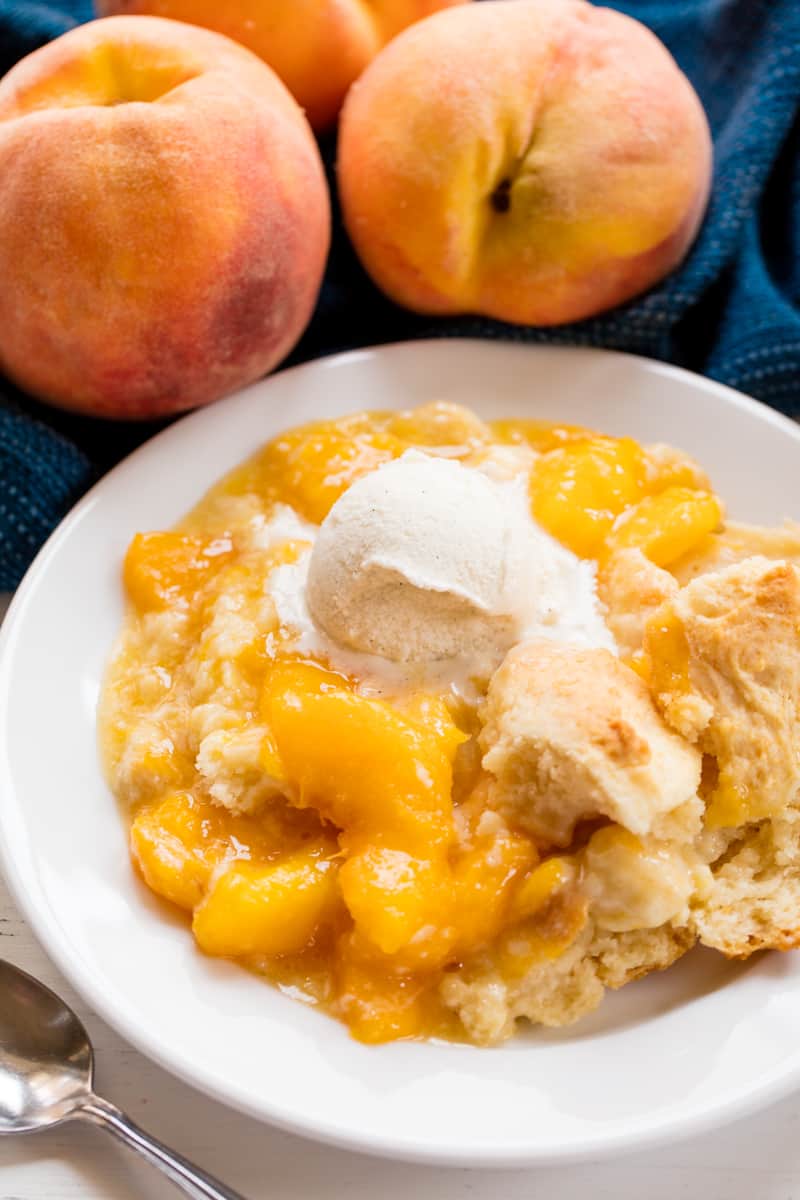
What makes this peach cobbler even better is how versatile it is. You can easily switch up the fruit if peaches aren’t in season—think berries, apples, or even a mix! Plus, it’s a great recipe to make ahead and reheat when you’re ready to serve. Whether you’re looking for a dessert to bring to a potluck or just want to treat your family to something special, this peach cobbler is your go-to. It’s a guaranteed hit every time, and you’ll love how quickly it comes together. Give it a try, and watch it disappear from the dish before your eyes!
Frozen Peaches
You can definitely use frozen peaches for this cobbler, but be aware that they might make the dessert a bit runnier due to the extra moisture. To get the best results, let the peaches thaw at room temperature for about 30 minutes before using them. To compensate for the additional moisture, double the amount of cornstarch in the recipe. This will help thicken the syrup and keep the cobbler from becoming too watery.
Canned Peaches
Canned peaches are a convenient option and work well in this recipe. For the best results, choose peaches canned in light syrup or no syrup at all, as syrup adds extra sugar to the dish. If your canned peaches are in syrup, you can rinse them off to remove some of the excess sugar. The same applies if you’re using home-canned peaches—rinse off the syrup before continuing with the recipe. This will help maintain the desired sweetness and consistency of your cobbler.
Fun Food Facts
Did you know that cobblers traditionally don’t have a bottom crust? Some families might prepare them that way, but technically, a cobbler with both a bottom and top crust is more like a pie.
How to Choose Your Peaches
Freestone peaches are ideal for baking because their pits are easy to remove, and they provide a juicy yet firm texture that holds up well in the oven. Ultimately the best choice for your peach variety is the freshest available near you. We love our backyard peach trees and local farm stands.
To determine if a peach is ripe and juicy, look for these signs:
- Color: A ripe peach should have a deep golden hue to its yellows. The richer the golden color, the better the flavor.
- Firmness: Gently squeeze the peach. If there’s slight resistance and it’s not overly soft, it isn’t quite ready. Ripe peaches should have a soft feel when gently squeezed.
- Wrinkles: Check for wrinkles near the stem of the peach. Wrinkles indicate that water has evaporated, concentrating the peach’s flavor for a more intense taste.
Storage & Reheating Instructions
Refrigerate leftovers by covering the pan with a lid or plastic wrap, or transfer portions to an airtight container. Store in the refrigerator for up to 4 to 5 days.
Reheat by placing the pan back in a 350-degree oven until warmed through, which typically takes about 15 minutes. Or microwave portions in 20-second increments until warmed through, stirring in between to ensure even heating.
Freeze leftover cobbler in a freezer-safe, airtight container. Thaw overnight in the refrigerator and follow the same reheating instructions.
More baked peach desserts…
Perfect Peach Pie
3 hrs
Best Ever Peach Crisp
45 mins
Peach Crumble
1 hr
Peach Dump Cake From Scratch
45 mins
Watch the video below where Rachel will walk you through every step of this recipe. Sometimes it helps to have a visual, and we’ve always got you covered with our cooking show. You can find the complete collection of recipes on YouTube, Facebook Watch, or our Facebook Page, or right here on our website with their corresponding recipes.

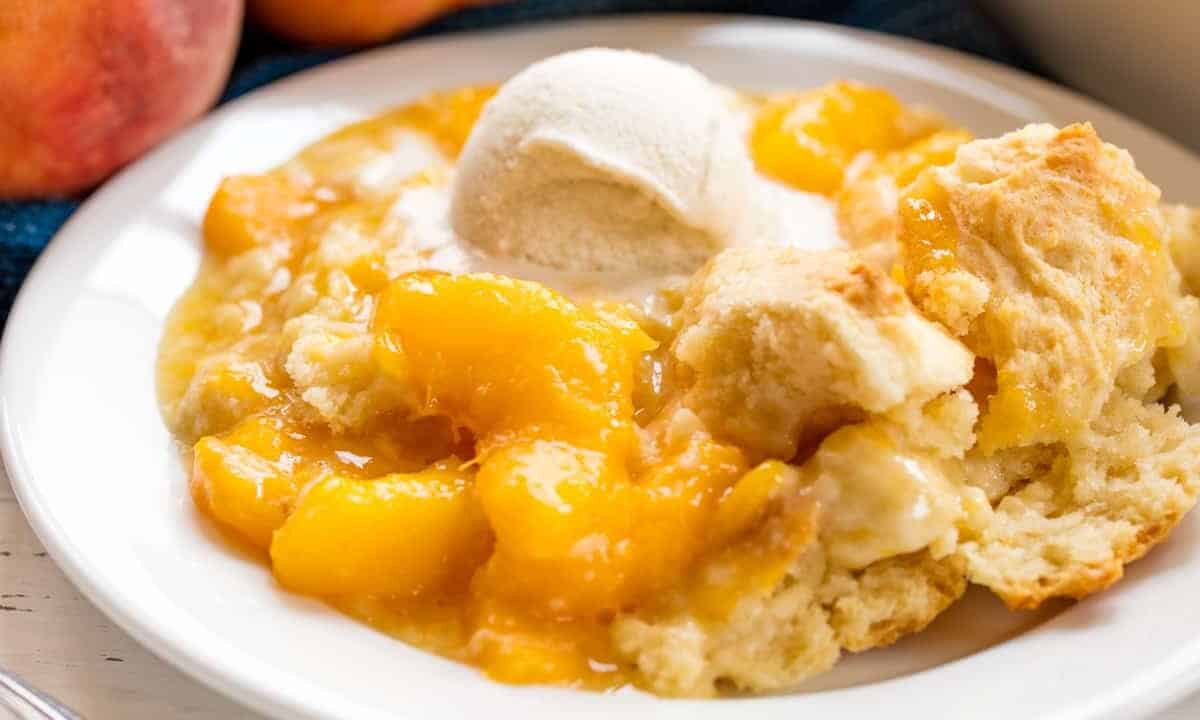
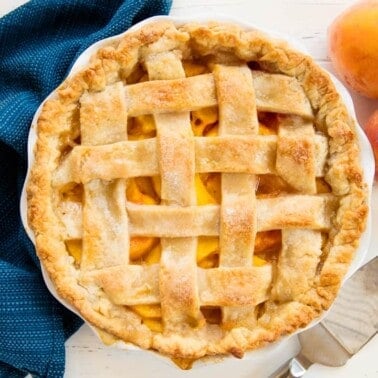
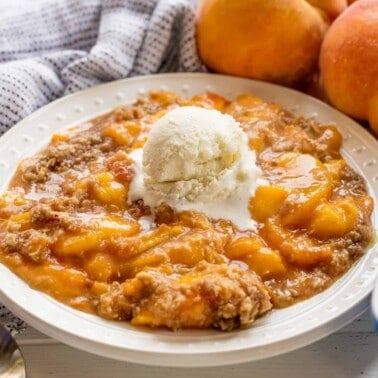
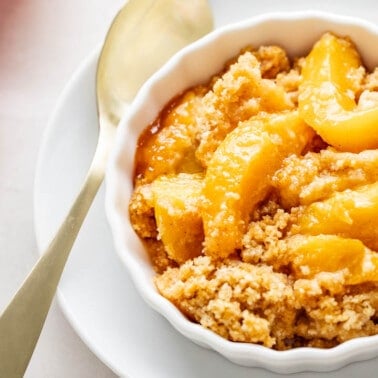
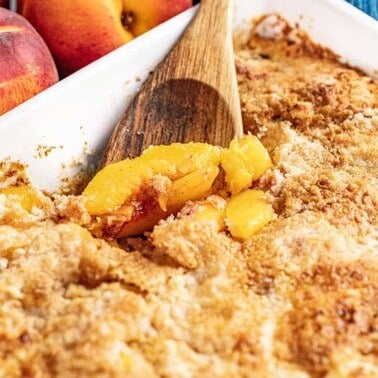
Love, love, love your recipes!
I love the stay at home chef. I’m 64 years old, a firefighter / paramedic, and a nurse. Work keeps me very busy but I try to set aside 2 weekends a month to cook and have friends over. The SAHC recipes are really good and so easy to follow. Thank you. You’ve made cooking fun for me again.
The biscuits were so good! Made half recipe using one can peaches in juice, drained. Melted butter in the dish before adding everything, just perfect! Food procesoor worked great. Will definitely make again.
I’ve made peach cobbler several times using frozen fruit, works every time. My family requested peach cobbler for Thanksgiving. Thanks for another great recipe 😁
Very good and easy to make. Love all your recipes.
I made this today with some wonderful Michigan peaches. It’s really good and it’s easy to make.
Has anyone tried cutback on the sugar? If so, how much and did it still taste good?
YUMMY
Made this today, and it’s a good thing I checked it after 45 minutes… my round was already a little darker than golden brown. Otherwise, it’s yummy!